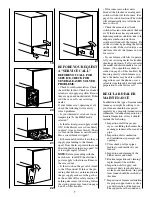
7
19
20
21
22
23
BEFORE YOU REQUEST
A “SERVICE CALL”
BEFORE YOU CALL FOR
SERVICE, CHECK FOR
SEVERAL EASILY SOLVED
PROBLEMS:
• Check for sufficient airflow. Check
the air filter for dirt. Check for blocked
return-air or supply-air grilles. Be sure
they are open and unobstructed. If this
isn’t the case, call your servicing
dealer.
If your furnace isn’t operating at all,
check the following list for easily
solved problems:
• Is your thermostat set above room
temperature? Is the HEAT mode
selected?
• Is the electrical power supply switch
ON? Is the blower access door firmly
in place? Are any fuses blown? (There
is a fuse on the furnace control board.)
Has a circuit breaker tripped?
• Is the manual shutoff valve in the gas
supply pipe leading to the furnace
open? Does the lever point in the same
direction that the pipe runs (open)? Or
is it at right angles (closed)?
NOTE:
Before proceeding with the
next checks, turn OFF the electrical
power supply to the furnace. Remove
the access door.
• Is the switch on the gas valve turned
to the ON position? If this or the pre-
ceding check shows an interruption in
the gas supply, make sure the gas has
not been shut off for safety reasons. If
nothing else seems to be wrong, follow
the startup procedures found on pages
4 and 5 of this booklet.
• If for some reason the vent is
blocked, the blocked vent safeguard
switch will shut off the furnace. (See
page 2 for switch location.) The switch
will automatically reset after the fur-
nace cools off.
• Check the manual-reset limit
switches located on the end of the burn-
ers. If the furnace has experienced a
high-temperature condition, due to in-
adequate combustion air, these
switches will shut off the furnace. Re-
set the switches by pushing the button
on the switch. If the switch trips a sec-
ond time, turn off the furnace and call
for service.
• If your furnace still fails to operate,
call your servicing dealer for trouble-
shooting and repairs. Tell your dealer
the model and serial numbers for your
furnace. (You should have them re-
corded on page 8 of this booklet.) By
knowing exactly which furnace you
have, the dealer may be able to offer
suggestions over the phone, or save
valuable time through knowledgeable
preparation for the service call.
REGULAR DEALER
MAINTENANCE
In addition to the type of routine main-
tenance you might be willing to do,
your furnace should be inspected
regularly by a properly trained service
technician. An annual inspection (or
biennial inspection, at least) should
include the following:
1. Inspection of all flue gas pas-
sages—including the burners, heat
exchanger, inducer, elbow, and vent
pipe.
2. Inspection of all combustion
and ventilation air passages and
openings.
3. Close check of all gas pipes
leading to (and inside of) your
furnace.
4. Inspection and cleaning of the
blower motor and wheel.
5. Routine inspection and cleaning/
replacement of the air filter.
6. Inspection of all supply- and
return-air ducts for obstructions,
air leaks, and insulation. Any prob-
lems found should be resolved at
this time.
7. Inspection of furnace installation
for proper support and any obvi-
ous deterioration of the furnace.
The support must be sound and


























